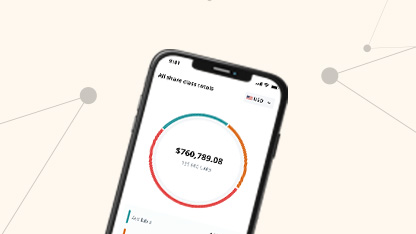Ordinary income tax and capital gains tax (CGT) are the two main types of taxes you need to know if you’re granted a stock option by your employer.
The tax treatment of stock options depends on the type you’re granted – incentive stock options (ISOs) or non-qualified stock options (NSOs or NQSOs). In this article, we’ll spell out how these two stock options are taxed with examples.
- Taxes on stock options
- NSO tax treatment at exercise and sale
- ISO tax treatment at exercise and sale
- Summary: How are stock options taxed?
Taxes on stock options
For NSOs (with a fair market value that cannot be readily determined), the tax implications are simpler – ordinary income tax at exercise and CGT at sale. If you hold your shares long enough before selling, your gains may be considered long-term and taxed at a lower rate at sale.
For ISOs, no income is recognized for the regular tax at exercise but you may have to pay an Alternative Minimum Tax (AMT). If you satisfy the holding period requirement, you only have to pay long-term CGT at sale. Otherwise, you’ll pay ordinary tax and short-term capital gains tax – if any – at sale.
The rate for the ordinary income tax is almost double that of the long-term CGT, so optimizing your plan to exercise and sell your assets can result in lower tax liabilities.
| Grant | Vesting | Exercise | Sale | |
| NSO | No tax | No tax | Ordinary income tax | CGT (long-term or short-term) |
| ISO | No tax | No tax | No ordinary income tax but subject to AMT | Ordinary income tax, and/or CGT (long-term or short-term) |
How are non-qualified stock options taxed at exercise?
When exercising your NSOs, you’ll need to pay ordinary income tax on the NSO spread – the market price at exercise minus the exercise price. In this case, you’ll owe federal, state and local income taxes as well as payroll taxes on the spread.
You must report this amount as a compensation element when filling out your tax return for the year you exercise your NSOs.
NSO tax example:
– Exercise price: $3 x 100 shares = $300
– Fair market value at exercise: $8 x 100 shares = $800
NSO spread:
Market price at exercise – exercise price
$800 – $300 = $500, taxed as ordinary income
Your employer usually helps facilitate tax withholding. Since the exercise of NSOs is considered compensation, they result in a tax deduction for the company.
How are non-qualified stock options taxed at sale?
There are two types of NSO sales – 1) after holding shares for more than one year of exercising and 2) within one year of exercising. Type 1) has a favorable tax treatment (see Example 1, below) because the long-term CGT rate is lower.
Some people want to sell their shares sooner as they may want to secure the profit or cover the exercise costs by selling right away (see Example 3).
Example 1. Holding period > 1 year of exercising:
– Exercise date: 07/01/2021
– Sale date: 07/31/2022
– Exercise price: $3 per share
– Fair market value at exercise: $8 per share
– Sale price: $10 per share (Total shares: 100)
Long-term Capital gain:
Sale price – Cost basis (exercise price + NSO spread)
$10 x 100 – ($3 x 100 + $500) = $200
Example 2. Holding period =< 1 year of exercising:
– Exercise date: 07/01/2021
– Sale date: 01/01/2022
– Exercise price: $3 per share
– Fair market value at exercise: $8 per share
– Sale price: $10 per share (Total shares: 100)
Short-term capital gain:
Sale price – Cost basis (exercise price + NSO spread)
$10 x 100 – ($3 x 100 + $500) = $200
Example 3. Selling stock right after exercising:
– Exercise date: 07/01/2021
– Sale date: 07/01/2022
– Exercise price: $3 per share
– Fair market value at exercise: $8 per share
– Sale price: $8 per share (Total shares: 100)
Short-term capital gain:
Sale price – Cost basis (exercise price + NSO spread)
$8 x 100 – ($3 x 100 + $500) = $0
This approach allows you to pay exercise costs with the immediate sale proceeds, secure the profit and diversify your financial portfolio.
Let’s have a look at ISO tax treatment.
How are incentive stock options taxed at exercise?
At exercise, the ISO spread (FMV on exercise minus exercise price) is NOT taxed as ordinary income but it is subject to the Alternative Minimum Tax (AMT). As the name suggests, it’s an alternate calculation to your regular tax liability. The AMT may be triggered when income is exempt from regular federal income taxes – your ISO spread at exercise is one such income item.
You need to report the spread amount as income for the AMT adjustment on IRS Form 6251. But, if you exercise and sell your shares within the same year, then no AMT adjustment is required . (Source: IRS Instructions to Form 6251).
Being subject to AMT doesn’t mean you have to pay AMT liability, as you need to do some math to determine your liability. To do so, you’ll need to compare your ordinary income tax with your tentative minimum tax (TMT). Since AMT is the excess of the TMT over the regular tax, the AMT is owed only if the TMT for the year is greater than the regular tax for that year (Source: IRS). Here are a couple of examples.
Case 1:
– Ordinary income tax: $300,000
– TMT: $340,000
Since your TMT is greater than your ordinary income tax (as the result of ISO exercise), you’ll pay an ordinary tax of $300,000 and an AMT of $40,000 ($340,000-$300,000).
Case 2:
– Ordinary income tax: $300,000
– TMT: $280,000
Since your ordinary income tax is now greater than your TMT, you’ll only pay an ordinary tax of $300,000. No AMT will be paid in this case. (Source: Adam Frank, Managing Director, Head of Wealth Planning and Advice, J.P. Morgan)
How to calculate TMT?
In general, you can compute the TMT by:
- Adding the ISO spread (FMV on exercise minus exercise price) to your total taxable income (and making certain other adjustments to income) = Alternative Minimum Taxable Income (AMTI)
- Subtracting the AMT exemption amount (for tax year 2022, $75,900 for singles and $118,100 for married couples filing jointly) from (1)
- Multiplying the amount computed in (2) by the appropriate AMT tax rate (26% for AMTI below $206,100 for married couples filing jointly and 28% for income above the threshold)
- Subtracting the AMT foreign tax credit = TMT
(Source: IRS.GOV)
If your regular tax is higher than your TMT each year, you don’t have to pay AMT. That may explain why some people haven’t heard of AMT. But, if you decide to exercise your ISOs this year and hold on to the shares, there is a good chance you’ll get an AMT bill.
How are incentive stock options taxed at sale?
There are two types of ISO sales – Qualifying disposition and Disqualifying disposition.
1. ISO qualifying disposition:
When you sell your ISOs at least 2 years after the grant date and at least 1 year after the exercise date, the difference between the exercise price and sale price is taxed as a long-term capital gain or loss. No ordinary income tax is charged in this sale.
– Grant date: 07/01/2020
– Exercise date: 07/01/2021
– Sale date: 07/31/2022
– Exercise price: $3 x 100 shares = $300
– FMV at exercise: $8 x 100 shares = $800
– Sale price: $10 x 100 shares = $1000
Long-term capital gain:
$1000 – $300 = $700, taxed at a favorable rate
Since the sale and the exercise events didn’t occur in the same year, you must have reported an income adjustment (i.e. ISO spread) for AMT purposes in 2021 – the year you exercised your stock options. In 2022 – the year you sold your shares, you will have a negative adjustment for AMT purposes, because your AMT basis in the stock (FMV at exercise) is likely higher than your regular tax basis (exercise price).
2. ISO disqualifying disposition:
When you sell stock acquired through ISOs in 2 years or less from the grant date or 1 year or less from the exercise date, you lose ISO tax benefits. People do so rather than hold on to them because they may want to avoid AMT (see Example 2a), cover the exercise costs, or simply secure profits.
Example 2A) Sell all shares right after you exercise your ISOs
The first part to consider is the bargain element – sale price (= FMV at exercise) minus exercise price. It is taxed as ordinary income and subject to federal, state and local income taxes.
– Grant date: 07/01/2020
– Exercise date: 01/01/2021
– Sale date: 01/01/2021
– Exercise price: $3 x 100 shares = $300
– Sale price: $10 x 100 shares = $1000
Part I: Ordinary Income: $1000 – $300 = $700
The second part is short-term gains (since you sold the stock less than a year after exercising) that is the difference between the sale price and cost basis – the exercise price plus the bargain element in part I.
Part II: Short-term gains: $1000 – ($300 + $700) = $0
Since the cost basis and the sale price are the same, you end up reporting no gain or loss on the sale transaction itself here. Also, no income adjustment for AMT purposes is needed as the exercise and sale events are in the same year.
Example 2B) Sell share in the next calendar year but less than 1 year after the exercise date
The first part to consider is the lesser of
– The bargain element: the difference between the exercise price and the FMV at exercise, or
– The gain: the difference between the exercise price and the sale price
It is taxed as ordinary income and subject to federal, state, and local income taxes.
– Grant date: 07/01/2020
– Exercise date: 07/01/2021
– Sale date: 01/31/2022
– Exercise price: $3 x 100 shares = $300
– FMV at exercise: $8 x 100 shares = $800
– Sale price: $10 x 100 shares = $1000
Part I: Bargain element: $800 – $300 = $500 < Gain: $1000 – $300 = $700
Ordinary Income = $500
Any additional gain is taxed as capital gain – Sale price minus cost basis (exercise price plus bargain element in part I)
Part II: Short-term gain: $1000 – ($500 + $300) = $200
In this case, you should have reported an income adjustment ($800 – $300 = $500) for AMT purposes in the year you exercised your stock options. You will have a negative adjustment to AMTI in 2022 – the year you sold your stock – because your AMT basis in the stock (FMV at exercise) is likely higher than your regular tax basis (exercise price).
Contact Us
Stock options are a type of equity compensation that J.P. Morgan Workplace Solutions manage for companies all over the world. Request a free demo to find out more about how to plan and administer employee stock options and our other products and services.
ISO Tax Summary:
| Grant | Vesting | Exercise | Sale | |
| Qualifying Disposition | – | – | AMT (No ordinary income taxes) | -Long-term CGT -No tax deduction for the employer |
| Disqualifying Disposition | – | – | AMT if selling shares in the next year. (No ordinary income taxes) | -Ordinary income tax -CGT -Employer’s tax deduction based on ordinary income reported |
NSO Tax Summary:
| Grant | Vesting | Exercise | Sale |
| – | – | -NSO spread taxed as ordinary income and subject to federal, state and local income taxes in addition to payroll taxes -Result in a tax deduction for the issuing employer | -Capital gains considered long-term if holding shares for at least 1 year of exercising -Otherwise considered short-term |
JPMorgan Chase & Co., its affiliates, and employees do not provide tax, legal or accounting advice. This material has been prepared for informational purposes only, and is not intended to provide, and should not be relied on for tax, legal and accounting advice. You should consult your own tax, legal and accounting advisors before engaging in any financial transaction.
By visiting a third-party site, you may be entering an unsecured website that may have a different privacy policy and security practices from J.P. Morgan standards. J.P. Morgan is not responsible for, and does not control, endorse or guarantee, any aspect of any linked third-party site. J.P. Morgan accepts no direct or consequential losses arising from the use of such sites.
This publication contains general information only and J.P. Morgan Workplace Solutions is not, through this article, issuing any advice, be it legal, financial, tax-related, business-related, professional or other. J.P. Morgan Workplace Solutions’ Insights is not a substitute for professional advice and should not be used as such. J.P. Morgan Workplace Solutions does not assume any liability for reliance on the information provided herein.



